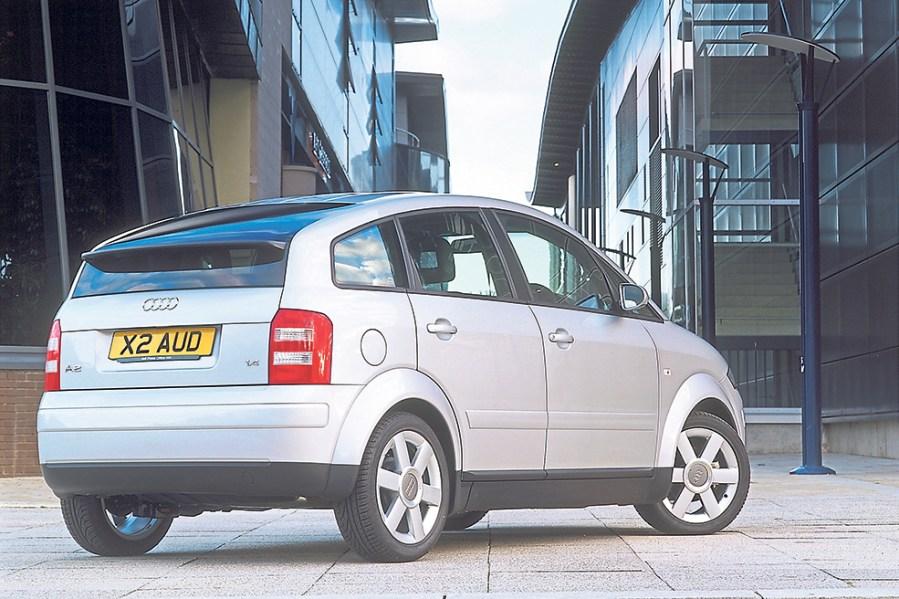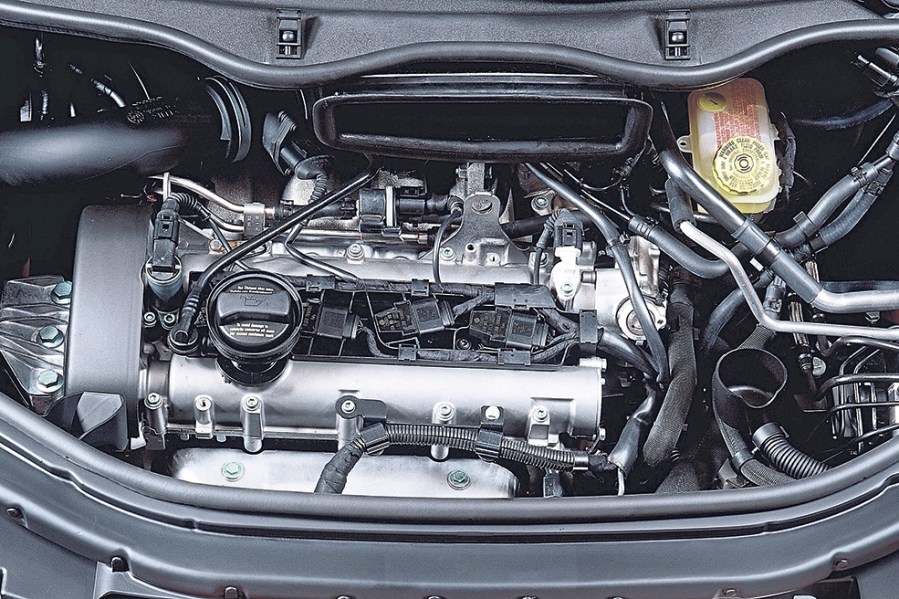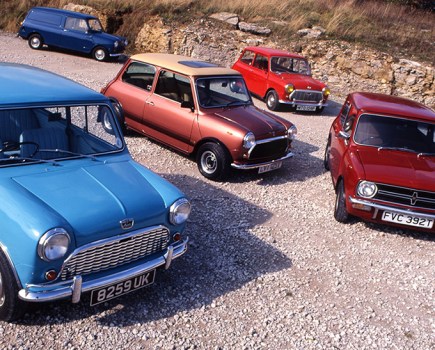The Audi A2 was a triumph of innovation over mass-market appeal and is now one of the best-value modern classics available
Words: Jon Burgess Images: Audi
Four years after the A8 previewed Audi’s Aluminium Space Frame (ASF), the AI2 concept car was unveiled at the 1997 Frankfurt Motor show, downsizing ASF for the purposes of a volume-produced supermini. A production car was imminent – but given its hi-tech construction, it wouldn’t be cheap. Laser-welded aluminium and aluminium alloy pressings, die-cast nodes, and extrusions made up the bodyshell of the newcomer – called the A2 for production – with self-supporting panels attached in a similar manner to the Rover P6 or Renault Espace.
At the front of the car, a so-called ‘service module’ (Serviceklappe) flap provided quick access to the oil filler, dipstick and washer fluid levels without removing the bonnet. If greater access was needed, two contra-rotating lugs took it off completely.
A sloping roofline, crucial for aerodynamics (0.28 CD), restricted space for aft passengers, and so a lowered rear floorpan – known as the Space Floor Concept – increased room. Similar in outcome to Hudson’s ‘step-down’ chassis design, it was vastly different in execution. A double-skinned boot floor housed the battery; the rear seats could be removed altogether if needed.
The result was a five-door hatch that, dependent on specification, weighed between 830 and 995kg; some steel French cars were lighter but lacked the Audi A2’s crash protection or space utilisation. Fuel efficiency, in petrol and diesel form, was at least on a par with these older designs too, with one variant – the not-for-the-UK 3L – making further sacrifices in the name of parsimony. So-called due to the metric three-litres-per-100km economy target it could achieve, thinner glass, smoother bumpers (and a lower 0.25 CD drag coefficient), a lighter bonnet, a reprofiled, larger rear spoiler and a 1.2-litre diesel engine resulted in an astonishing 94mpg (imperial), with careful press launch visitors managing over 100mpg on test.
Otherwise, the engine range offered to British buyers was akin to that of contemporary VW Polos: 1.4- and 1.6-litre petrol fours, and a 1.4-litre diesel triple were offered. Early cars had a 74bhp, 1.4-litre 16v; by September 2000, the 1.4 TDi was on stream. June 2002 saw the 109bhp 1.6-litre FSI petrol join the range; after August 2002, cars were fitted with a larger 41-litre fuel tank. By October 2003, an 89bhp 1.4 diesel could be had.

Bodywork
If you’re in the market for an Audi A2 today, you’re not worrying so much about rust, but minor prangs can cause a car to become a write-off. The A2’s body panels are also extremely prone to trolley dings and other damage, so check carefully along the car’s flanks for any imperfections and use these as a negotiating tool. The likes of the A2OC and A2-freun.de can help with spares.
Headlamps can cloud over from moisture getting inside their case, and the rear lighting is very sensitive to bulb voltages. Latches on the service module flaps can rust, denying access; if these have been regularly greased, it’s a good indication that the car has been cared for. Unsympathetic tyre bays can sometimes damage the sills by jacking the car in the wrong place, and car washes have been known to rip the rear spoiler off.
Engine and transmission
The Audi A2’s light-footedness means that its running gear is less stressed than it would have been in an equivalent Polo, Fabia or Ibiza. The 1.4 three-pot diesel appeared in three iterations in UK cars (AMF, BHC, 74bhp and ATL, 89bhp), alongside two versions of the 1.4i four-cylinder petrol (AUA and BBY, 74bhp) and a sole designation of the 1.6 FSI (BAD, 109bhp). It’s also worth noting that, while the petrols are Euro 4 (and therefore London Ultra Low Emissions Zone compliant, with pre-2002 cars needing a certificate of conformity from Audi to gain exemption), the diesels are Euro 3 and are thus liable for city clean air zone tariffs. The 1.6 FSI won’t run on E10, either, requiring ‘protection grade’ E5 petrol.
Many owners have reported problems with the exhaust flexi joint on the downpipe. Engine wise, the 1.4-litre petrol, as per its fitment in other VW Group cars, can give coil pack issues, but is otherwise reliable. The lower-powered diesel three-pots behave themselves, but the more ambitious 89bhp ATL units can generate large bills owing to their dual-mass flywheels and variable geometry turbos.
The most powerful 1.6 FSI engines give trouble with their direct-injection heads and emissions controls; rectification can cost more than the value of the car.
There are few issues to report with the five-speed Getrag manual gearbox in the Audi A2; an automated manual was fitted to the 3L models, but they never came to the UK. Tower selectors on the box itself can get wet and make the gearchange notchy, but otherwise, the gearboxes are sound.

Suspension, steering and brakes
Wear rates of bushes, dampers and springs on the Audi A2 is less than you might expect, apart from Sport models whose firm ride and large 17-inch wheels give the hardware a workout. Until 2002, wishbones were cast; after that, Audi reverted to pressed steel items, which can fail over time. Anti-roll bar bushes can also give out; OEM replacements aren’t available, but oversize items will fit without the sleeve of the original item. Check top mounts, too; their fixings can seize with age.
It’s standard VW Group fare as far as brakes are concerned – they’re not working particularly hard, even at the front, but the rear discs (used on the diesels and 89bhp-109bhp cars) can corrode from how sparingly they’re used, even if the car is a daily driver. ABS, brake wear indicator and handbrake cables can chafe over time, and the handbrake mechanic has a vulnerable Y-joint that can seize, giving low handbrake efforts either side.
Interior, trim and electrics
Six trim levels were available throughout the Audi A2’s life: standard, Sport, SE, Colour Storm, Colour Storm SE, and Special Edition. Cloth, leather and Alcantara trim was fitted dependent on specification, with the latter two being the hardest to find in good condition (owing to their higher prices on the showroom floor). Expect bolster wear on the drivers’ seat, regardless of trim; these cars are getting on and sometimes attracting less sympathetic owners. Pixels can also burn out in the instrument pack display and HVAC controls on higher-spec cars.
Bear in mind also that, in the interests of weight saving, the loom of any given A2 was tailored to each car. If you want to upgrade anything electrical, you’ll need to splice the extra connectors and blocks in from a donor car. As ever, check everything works.
Soft-touch plastics may have won plaudits in magazines when new but are now wearing off, leaving the functions of some buttons hard to discern. Check that the fuel flap release works; if it doesn’t, the emergency pull is hidden by a piece of boot trim on the offside. Sliding glass roof motors can give up but can be repaired; check also for broken drivers’ door locks.
Water ingress can be a problem, particularly if the car has sat. Air conditioning, if fitted, needs its drains checking for clearance; check also the A and C pillars, and the around the spoiler and battery compartment, which lives in a fake floor under the boot.

Audi A2: our verdict
Alas, the A2’s styling (by Lamborghini Murciélago designer, Luc Donckerwolke) was just too avant-garde for supermini buyers. Its high price (within £2000 of a basic A3) made little sense to Joe Public, despite how good on fuel the A2 was. Audi lost money on each unit made, only clawing a fraction of it back in optional extras, pushing Special Edition cars hard as the sole UK models available in the last year of production. It was making more TTs and A8s per year than A2s, with 176,377 cars completed in a five-year run.
Owing to their complex construction, residuals of A2s eventually tumbled, with many written off for even minor repairs. Enthusiastic owners’ groups, including A2OC (a2oc.net) and A2-Freun (a2-freun.de), do their best with what survives; serviceable cars start from as little as £1000, with the more highly specified and less popular shades (as well as the pair of 2002-2004 Color Storm series cars) fetching the most money dependent on condition. Around £4000 is the ceiling for a low-mileage A2, with £2000-2500 buying one that’s presentable and well-maintained.
In the current climate of crowded roads and soaring fuel prices, the lithe and minimalist A2 is long overdue recognition.

















